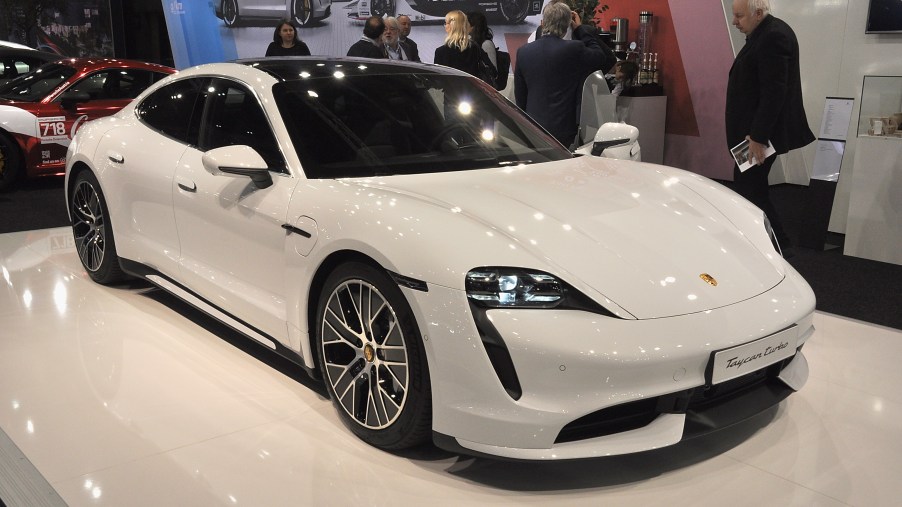
Should I Buy a Tesla or a Porsche Taycan?
In 2002, before Tesla became the most valuable auto company in the history of the United States, Elon Musk had a dream: to convert his Porsche 911 Turbo into an all-electric vehicle. Musk approached the founder of AC Propulsion, Alan Cocconi and asked if he’d do it for $250,000. For whatever reason, Cocconi declined the offer which led to Musk investing in Tesla Motors in 2003 — in short anyway.
Now, nearly 18 years later, the Porsche 911 might be the best car to buy in 2020, but is the Porsche Taycan the best electric sports car? With sources like Digital Trends listing Tesla as still the top electric automaker, how does the Porsche Taycan stack up against the Model S?
The Taycan Turbo S vs. the Model S performance
In mid-2019, Germany automaker Porsche debuted the Taycan Turbo S, an all-electric sports car. Since then, countless blog posts and YouTube videos have been touting it as Tesla’s newest and toughest contender. Base priced at roughly $103,000 for the stock Taycan 4S and around $190,000 for the Taycan Turbo S, the only competition is who can burn through their cash the fastest.
Mechanically speaking, Tesla has electric vehicles figured out, and that becomes easier to see as you compare its specs to the Porsche.
Other than being a status symbol, don’t expect to reach 60 miles per hour quicker than the Model S — nor a faster top speed for that matter.
Even if one were to purchase the optional Performance Battery Pack offered with the Taycan, the Model S still brings the pain. That Performance Battery Plus option is an additional $6,500 but reaches 80 percent capacity in 20 minutes. That is 10 minutes sooner than Tesla’s battery (charging both at a rate of 150 kilowatts), so at least you would have shorter pit stops.
All three models of Porsche feature “over-boosting” which provides a tiny boost to their overall torque and speed, with the Turbo S producing around 750 horsepower and 774 pound-feet of torque. Considering this is all battery power and no engine, it still puts even the Dodge Challenger Hellcat to shame yet falls a little short of the Tesla Model S (that doesn’t require a boost to get it there).
Without special Performance Battery Packs or over-boosting, the Model S only produces around 762 horsepower and only 723 pound-feet of torque. But don’t let the lack of torque fool you because that equates to less tire slippage compared to the Turbo S. On the flip side, 4S suffers the least in the tire slipping department but at a notable loss in both horsepower and torque (so what’s the point).
Comparing powertrains
Tesla has always proclaimed its vehicles are the longest range of all-battery powered cars on the market. The Environmental Protection Agency (EPA) backed up that proclamation by giving its Long Range Plus trim a rating of 390 miles (630 km) as of February 16, 2020.
The Model S Performance slightly lags behind with an EPA rating of 365 miles (587 km). Both Tesla models use a 100 kWh lithium-ion battery, which is interesting since both the Taycan 4S (using a Performance Battery Pack) and the Taycan Turbo S have EPA ratings ranging between 77 and 109 miles less than the Model S Performance.
Both Porsche and Tesla trim varients are powered by two batteries in the front and the back; all trim variants have their batteries located in the floor as well. Nevertheless, Porsche’s Taycan is driven by two permanent-magnet synchronous motors while Tesla’s Model S has an older induction-type motor in the front and a permanent-magnet synchronous motor in the rear. Maybe therein lies the secret behind the Model S’ longer ranger.
Comparing the tech inside
When it comes to the kind of tech that comes with a vehicle, it’s mostly a matter of personal preference. Nevertheless, when stacked up against the Porsche Taycan, it’s tougher for the Tesla Model S to compete. Tesla has a reputation for having the biggest infotainment touchscreen (17-inch portrait-style) to come standard in a car and a 12-ish-inch screen replacing the gauge cluster — and that’s where the excitement ends.
The Porsche Taycan, on the other hand, features a 16.8-inch screen gauge cluster capable of displaying multiple features. A 10.9-inch infotainment screen is centrally located alongside a second 8.4-inch screen dedicated to climate control features, as well as handwriting recognition. Additionally, the front passenger is afforded their very own infotainment screen.
While the Model S does allow you to stream music via Bluetooth, over-the-air updates, and built-in Slacker Radio capability, the Taycan offers Apple CarPlay and Android Auto. If one says “Hey, Porsche” out loud, Porsche’s new digital assistant will respond.
For those who are comfortable with their car doing the driving (somewhat), Tesla has its Autopilot with lane-holding highway assist. It’s been around for years, so one would like to believe Tesla has a solid lead on such technology. The Porsche Taycan lacks anything like it. Then again, if you spent over $100,000 on a Porsche, battery-powered or otherwise, it’s safe to assume Autopilot would be the last thing on your mind.
At the end of it all, Apple CarPlay or not, if it’s performance, range, and price you’re looking for, the Tesla Model S seems the better choice at this point. This holds especially true when considering why someone would want to buy an electric car in the first place. The Model S (or any other Tesla vehicle) is considered a luxury vehicle after all — a more affordable, greener luxury vehicle. Nonetheless, time will tell whether or not Tesla can continue to outpace Porsche, being that Porsche is already a solid contender so early on.


